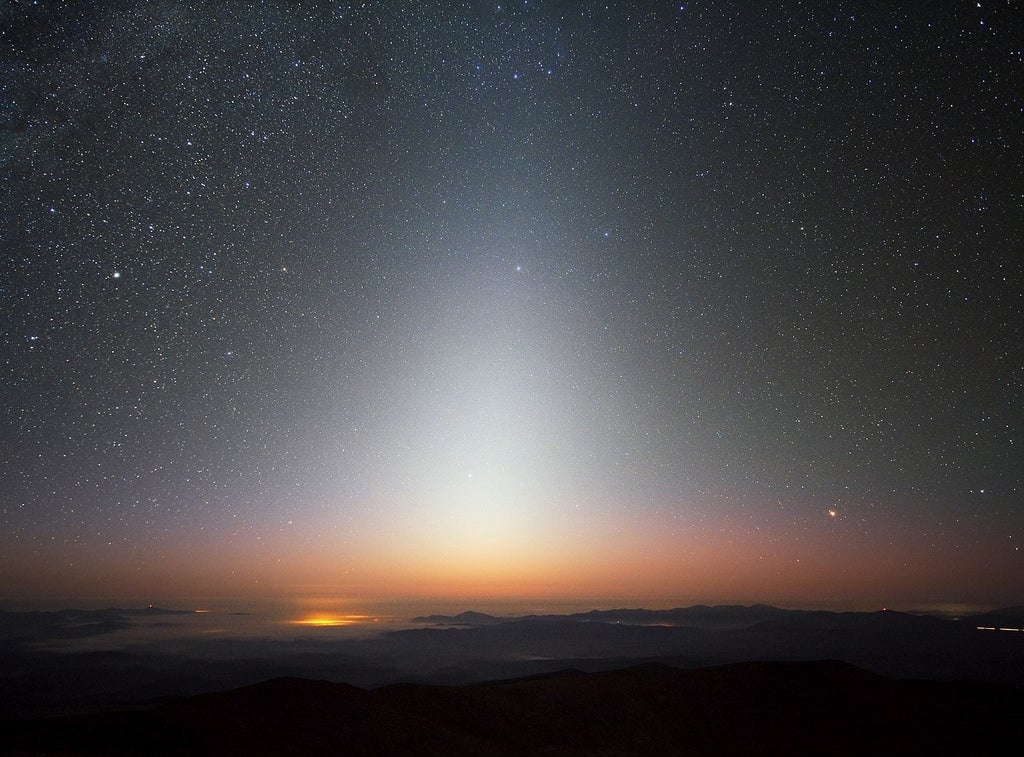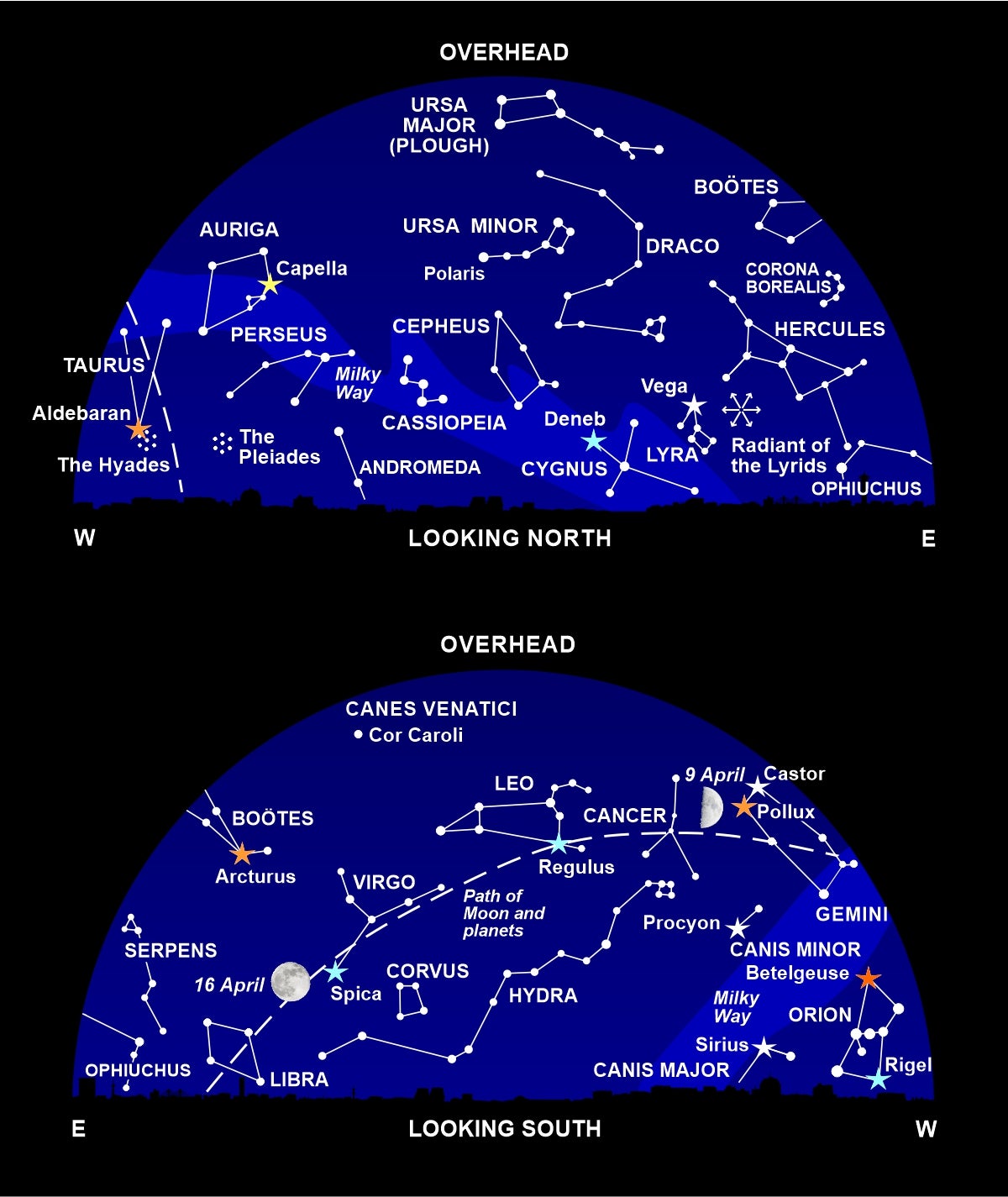
The sunny day merged into a translucent evening as I drove through the Arizona desert, promising an ideal night for stargazing once the twilight faded from the sky. But the dusk glow, viewed in my rearview mirror, seemed interminable. In frustration, I pulled over, killed the car lights and stepped out to look behind. Instead of a twilight band of light stretching along the horizon, I saw a narrow cone of opalescent light reaching upwards.
From Aries, it stretched past the glistening Pleiades star cluster to the horns of Taurus the bull – along the zodiac, the path followed by the moon and planets in the sky. As an astronomer, I knew of this phenomenon; had even glimpsed it from the murky skies of the UK; but now in the American desert I was seeing in its full glory the fabled zodiacal light.
Though but a footnote to western culture, its appearance above the Arabian desert has made the zodiacal light a key element of Islam. During Ramadan, Muslims can only eat at night. When the sky brightens in the early hours of the morning, they have to distinguish the vertical radiance of the zodiacal light – the false dawn or wolf’s tail – from the horizontal glow of the true dawn, marking the recommencement of fasting.
We see the zodiacal light most clearly when the line of the zodiac rises almost vertically above the horizon. The false dawn is prominent in the autumn, while the evening zodiacal light is best seen right now, in springtime.
If you don’t have a desert handy, travel to somewhere with a clear dark horizon to the west. The top of a high mountain is ideal, or a sea horizon. Make sure you are totally away from artificial lights, and the moon is not in the sky. Wait patiently for the wolf’s tail to linger in the sky as the rest of the heavens turn dark. The blacker your sky, the higher the zodiacal light will seem to rear. Under the best conditions, it reaches up to a slightly brighter spot – the gegenschein – which lies as high in the sky as the Sun is below the horizon.
Astronomers are in no doubt that the zodiacal light is caused by a thin disc of dust particles, orbiting in the same plane as the planets, and illuminated by the sun. Though this zodiacal cloud is widespread, there’s not much to it: if you put all this material together, you’d make a world only one-millionth the mass of the Moon.
But researchers are much less confident about the origin of this interplanetary pollution. Until recently, they thought the dust came either from disintegrating comets or from the collision of rocky bodies in the asteroid belt between Mars and Jupiter. A serendipitous discovery has now overturned that certainty.
Next time I catch the celestial wolf’s tail, I’ll be pondering how amazing it is that a phenomenon you can see with your naked eye is still perplexing twenty-first century science
Nasa’s Juno spacecraft was launched towards Jupiter in 2011, on its way to rendezvous with Jupiter. As it wended its way through interplanetary space, cameras on board recorded a hailstorm of particles spilling off from the spacecraft. After discounting the dire possibility of a fuel leak, they realised they were seeing specks of material being sandblasted off Juno’s large solar panels. And what was spattering the solar panels had to be the dust particles of the zodiacal cloud.
By the time the mission reached Jupiter, the Juno scientists had been able to map the distribution of these particles in the solar system. To their surprise, it does not reach out as far as the asteroid belt. Nor does it extend closer to the sun than the Earth’s orbit, where you would expect to find a lot of dust from comets.
Instead, the material of the zodiacal cloud is concentrated around the orbit of Mars. In some ways, that’s not too surprising: the red planet is the dustiest world in the solar system, its vast deserts are covered with fine material that is whipped up into planet-smothering sandstorms. But it is not easy to explain how it escapes Mars’s gravity and ends up in interplanetary space.
Next time I catch the celestial wolf’s tail, I’ll be pondering how amazing it is that a phenomenon you can see with your naked eye is still perplexing 21st century science.
What’s up
This month, the familiar shape of the Plough is right overhead. These seven stars are known as the Big Dipper in North America, and the Wain – an archaic term for a wagon – across much of Europe. To the Greeks, they form the body and tail of the Great Bear (Ursa Major in Latin). Originally the beautiful nymph Callisto, Zeus gave her an ursine shape to protect her from his jealous wife, Hera.
Below, you will find the Little Bear, Ursa Minor, the son of Callisto and Zeus. Marking the end of its tail is Polaris, the Pole Star, which always lies due north.

High in the southern sky rides the celestial lion, Leo, with the twin stars of Gemini to the right and bright orange Arcturus to the left. Below, the blue-white star Spica is the leading light of Virgo (the Virgin).
From 10 April onwards, look low on the western horizon after sunset to catch a glimpse of Mercury putting on its best evening appearance of the year. The innermost planet is shining as brightly as stars such as Arcturus and Spica, and there is a lovely sight at the end of April as Mercury passes close to the Pleiades (the Seven Sisters star cluster).
There is more planetary action in the southeastern sky before dawn. Most brilliant is the Morning Star, Venus, with Mars and Saturn forming an equally matched pair to its right. Jupiter lies to the lower left of Venus, and during the month the two brightest planets draw ever nearer to each other, as they head towards a close encounter on 1 May.
We are treated to a display of shooting stars on the night of 21-22 April, as the Earth ploughs into a trail of dust strewn by Comet Thatcher. The Lyrid meteors seem to stream outwards from a radiant near the bright star Vega, in Lyra.
People in parts of South America and the Pacific Ocean will experience a partial eclipse of the Sun on 30 April, but nothing is visible from North America or Europe.
Diary
9 April, 7.48 am: first quarter moon near Castor and Pollux
11 April: moon near Regulus
12 April: moon near Regulus
16 April, 7.55 pm: full moon near Spica
21 April: maximum of Lyrid meteor shower
23 April, 12.56 pm: last quarter moon
29 April: Mercury at greatest elongation east, near the Pleiades
30 April, 9.28 pm: new moon; partial solar eclipse; Mercury near the Pleiades
Philip’s 2022 Stargazing (Philip’s £6.99) by Nigel Henbest reveals everything that’s going on in the sky this year.







